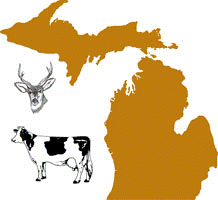Wildlife Disease and Zoonotics
Date of this Version
2005
Abstract
The role of European wild ungulates in the epidemiology of tuberculosis (TB) is still under discussion. This study describes the geographical distribution and molecular typing of 77 Mycobacterium tuberculosis complex isolates belonging either to M. bovis or to M. caprae, cultivated from hunter harvested red deer (Cervus elaphus) and European wild boar (Sus scrofa) in 24 Spanish localities, and compares them with spoligotypes detected previously in humans, livestock or wild animals, as described in the literature. The distribution of the molecular type patterns suggests that the population of M. tuberculosis complex strains isolated from Spanish wild ungulates is spatially structured despite the lack of important geographical barriers and despite the increasingly frequent wildlife translocations. Red deer and the European wild boar can share the same molecular types in localities in which the M. tuberculosis complex was isolated from both species. Strains of bovine and caprine origin do circulate in the same local wildlife populations. Six out of 11 spoligotypes were similar to types described in human cases. The isolation of TB strains in fenced estates from wild animals that have not had contact with domestic livestock for at least the past two decades, strongly suggests that the M. tuberculosis complex is able to survive in these populations. Therefore, wildlife including cervids and the wild boar need to be considered in the epidemiology and control of tuberculosis.



Comments
Published in Vet. Res. 36 (2005) 43–52.